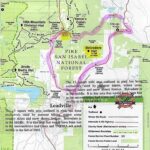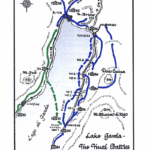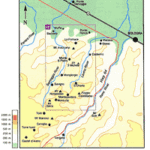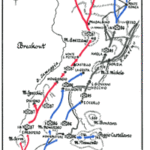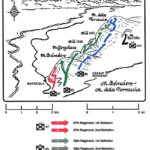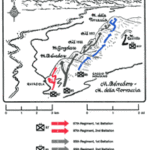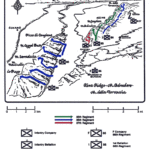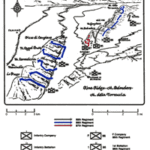
History of the Hut
The Sangree M. Froelicher hut was built in 1998 and originally called the Belvedere Hut, as a memorial to the 975 men killed in action and 3891 wounded in the Apennine Mountains of Northern Italy in the spring of 1945, during WWII. The Belvedere Hut was privately owned, rented to the public, and booked by the 10th Mountain Division Hut Association (10th Mountain Division Huts.)
During the summer of 2002, 10th Mountain Division Huts found it had a real problem on its hands. It’s eastern most contract hut, Belvedere, was privately owned and the two Leadville owners had received an unsolicited offer to purchase the hut, think chalet. Unfortunately the would-be buyer was a large commercial snowmobile tour operator located just east of Leadville on Colorado 91. It was his plan to turn the hut and the 40 acres of fee land on which it stands, into his mountain operations center. Cross country skiing, snow shoeing and hiking through quiet forest and alpine meadows would be “out” while hundreds of snowmobiles would be “in”.
Fortunately for 10th Mountain Division Huts, the Belvedere owners, who were most supportive of and friendly to 10th Mountain Division Huts, had previously provided a right-of-first-refusal to 10th Mountain Division Huts.
Aware that Denver’s F. Charles Froelicher’s brother, Staff Sergeant Sangree Mitchell Froelicher, 1st Platoon, Company B, 1st Battalion, 86th Mountain Infantry, had been killed in action in Sassomalare, Italy, on March 4, 1945, 10th Mountain Division Huts invited him – Chuck – to lead an effort to raise the considerable funds necessary to purchase and endow the hut. Chuck graciously accepted the invitation, provided an alternative way to honor and recognize the name Belvedere would be found.
The project had several components, each of which was important to our state and nation:
- The preservation and protection of 15 square miles of prime open space in the Pike/San Isabel National Forest (please see Map of Area).
- The addition, rather than the loss, of one of 13 huts in the astonishingly successful 10th Mountain Division Hut System.
- The honoring of yet another 10th Mountain “Trooper” who was killed in action in Italy in the spring of 1945, this time Sangree M. Froelicher.
On September 12, 2002, Chuck formed a committee to provide support and help. It included members of his family and old friends from Denver, Baltimore, Aspen and Vail. This committee made astonishing progress. Starting with a major grant from Denver’s Gates Family Foundation, and donations from other family foundations, veterans, Sangree’s family and admirers of the 10th Mountain Division. The necessary funds were raised, and the hut was purchased by 10th Mountain Division Huts in 2003.
All participants and donors to date have wanted to know Sangree “Mitch” Froelicher better. For this reason Chuck Froelicher wrote Profile of a Trooper, which is linked in the menu above. It is a remarkable story about a 21-year old young man from Baltimore who was posthumously awarded the Silver Star for his “courageous and aggressive leadership” on the day he died.
Profile of a Trooper – Sangree M. Froelicher
By Chuck Froelicher
Fighting for freedom and serving the United States of America in times of need were not new to Sangree Froelicher’s family. Serving under General George Washington in the Continental Army from 1776 to 1779 were Private Henry Hubbell, his father Lt. Colonel Nathaniel Hubbell, Captain Michael Carl and Major Daniel Barnitz. Sangree was a direct descendant of each through his maternal grandmother Mary Helen Hoke Sangree.
During World War II his first cousin Charles Froelicher Mitchell, serving under General George S. Patton, was killed in action in Sicily in 1943. His brother, Lt. J.G. Jackson Froelicher Mitchell, U.S.N.R., served as a line officer aboard the troop ship Susan B. Anthony. It was torpedoed and sunk on June 6th, 1944, D Day, in the English Channel. Jackson survived and went on to serve on the aircraft carrier Saratoga in the Pacific.
His uncle, Brigadier General Carl Sangree served with distinction in the 8th Air Force in England from 1942 to 1945.
Sangree was born outside of Philadelphia on November 23, 1923. His birth preceded mine by just over one year. Our father, Hans Froelicher Jr., practiced law in Philadelphia but in 1932, moved to Baltimore Maryland to become Headmaster of the Park School. We followed soon thereafter.
There were five children in the Froelicher family, Hans III, Joyce (Judy), Sangree, Charles and Fred. During World War II, in spite of being Philadelphia Birthright Quakers and eligible to be conscientious objectors, all four boys served in the Armed Forces while sister Judy became a US Navy cryptographer.
In his last two years at the Park School, Sangree competed vigorously and successfully in soccer, basketball and lacrosse. In 1941, he was Vice President of the Student Council, captained the lacrosse team and led it to an undefeated season. In the process, he was elected to the Maryland All State Lacrosse Team.
In the fall of 1941, Sangree went off to Colgate University. It was a perfect fit.
In the spring holiday of 1943, all young men our age were required to declare a preference for the Navy, Marine Corps, Army or Air Force. Sangree and I agreed on the Navy and walked down to the Fifth Regiment Armory to sign up. After the eye exam, I was sent on down the hallway. He was next. By the time he was through, I was on my way and into a Naval Training Program. We met at the end of the day and were not happy. He was colorblind and had been ordered into the Army. We had hoped to serve on the same ship.
Once back at Colgate, Sangree found a number of his friends were joining the newly founded elite “ski” troops. The unit required both intelligence tests and special physical qualifications. He passed and turned down continuous offers to go to Officer’s Candidate School, as did his friends who had also made the cut. In June of 1943 he reported for duty at Camp Hale, Colorado. When he dropped his duffel bag on the barracks floor, he turned around and found a dozen friends. They had all dropped out of law, medical and engineering schools to join the 10th Mountain Division. The Division was ranked by the War Department as having more brainpower than any other unit in the US Army.
Fast forward through 18 months of, at that time, the most rigorous combat training ever devised. It was legendary. Today it would be called Ranger or Special Forces Training.
On December 15, 1944, the 86th Regiment, sailed on the USS Argentina from Hampton Roads, Virginia, landing in Naples, Italy on December 23rd. On Christmas Day, Sangree’s 1st Battalion, moved 300 miles north by train to Pisa where they stayed for five days. Then it was 50 miles north to Porretta Terme by truck. On January 8th and 9th, the 1st Battalion of the 86th Mountain Infantry moved into the front line with Monte Belvedere nearby to the northeast and Riva Ridge to the west. B Company marched the final 10 miles from Porretta Terme to Vidiciatico through ice and snow at night with full packs. When D Day was finally planned, it was to be the task of the First Battalion of the 86th Regiment to assault and capture Riva Ridge.
The take off point was to be the hillside village of Vidiciatico lying just east of Riva Ridge. Riva was a mile long, running southwest to northeast. Its cliffs towered a thousand seven hundred feet off the valley floor on the east and two thousand five hundred feet off the valley floor on the west.
On the night of February 15th, Col. Henry J. Hampton, 1st Battalion Commander of the 86th Mountain Infantry, called in “five expert” mountaineers: First Sergeant Casperson, Staff Sergeant Froelicher and three others to make a night climb to Pizzo di Campiano, the easternmost peak on Riva Ridge. Their mission was to infiltrate, capture and bring down prisoners for intelligence purposes – and to assess the enemy strength. The route traveled, later known as #1, was covered by snow, ice and rocks. It took four and a half hours to reach the summit. At midnight, when they got to the top, a barking dog led three Germans to a point just a few yards above the patrol. Casperson said “Hands Up!” The Hampton reports tells us that one of the Germans then reached for his carbine whereupon “Froelicher & Casperson opened up with Tommy Guns.” The three men fell and the patrol headed down the cliffs with German “bullets splattering all over the mountain.” The two sergeants had fired the first shots in the 10th Mountain Division’s effort to test and eventually break through the Germans “Winter Line.” They concluded that the taking of the ridge by the 1st Battalion on the 86th was do-able in a night assault. Sergeant Carl Casperson was killed in action seven days later at Pizzo di Campiano, close by where he and Sangree had been on the night of the 15th.
Three nights later, on February 18th, four rifle companies of the 1st Battalion of the 86th Mountain Infantry left the base of Riva Ridge at 1930 hours, an hour after dark. The companies, consisting of a total of approximately seven hundred men, started up Trails 1, 2, 3 and 4 on the rock- and ice-covered 60% degree slope. They personally carried only a canteen of water. “Food would follow the assault.” Each rifleman carried a bayonet, a number of hand grenades, a carbine, or BAR (Browning automatic rifle) and as much ammunition as possible. They were under strict instructions to use only bayonets and hand grenades until dawn. The flash of a fired gun at night does nothing but make the shooter an easy target.
At 0117 hours on the morning of February 19th, Sangree’s First Platoon had taken Riva Ridge’s highest point, Cappel Buso. The rest of the company followed. The final 400 yards was a fierce firefight. Six wounded in action. The Germans retreated to the west. By 0300 hours, Riva Ridge had been secured. For over a year, the ridge had been used by the Germans to spot targets for their 88-millimeter artillery weapons, the best in the world. The 88’s were what had stopped General Clark’s troops during the preceding nine months. In the early morning of February 19, 1945, Riva Ridge had been taken without a 10th death.
At 2300 hours, on February 19th, the 85th and 87th Regiments, and that part of the 86th that was not on Riva, attacked Monte Belvedere just to the northeast. The Winter Line broke.
The “no casualty” state of affairs on Riva Ridge was too good to last and on February 20th, Germans counterattacked in force, particularly in the eastern most section, known as Pizzo di Campiano. Company A had secured it the night before. At the end of the counter attack, six men from the 1st Platoon of Company A lay dead with three wounded. B Company Commander Seigman then ordered Lieutenant Hallett, Sergeant Casperson, Sangree and the 1st Platoon of B Company to relieve Company A. While the platoon killed twenty-six Germans, Sangree’s Company B had lost eight killed in action and seventeen wounded, all close friends. Twenty-five casualties out of approximately 140 riflemen. A sixteen percent casualty rate in their second firefight. The blood of the 86th Regiment had been shed and much more would follow.
Following sixty hours with only one K Ration, the 1st Battalion was finally fed on February 21st.
There is no way to summarize the next ninety days except to report that during that period, the three rifle and one heavy weapons platoons in Company B, approximately one hundred forty men in all, suffered the loss of thirty-seven killed and sixty-eight wounded, a casualty rate of 75%. This rate was neither higher nor lower than the other rifle companies. Every study I’ve made has told me that a 75% casualty rate over 100 days in 10th Mountain Division rifle companies campaign was routine. But not to their families. The Tenth’s monthly casualty rate average of 1,209 was the highest of any Division in World War II.
D day and H hour for the 85th and 87th Regiments was at 11 pm on February 19th when they launched the spring offensive by assaulting and capturing Monte Belvedere in a fierce but successful battle. The assaults continued to the northeast for the next 12 days.
March 4, 1945 marked an epic day in the lives of the Froelichers. I had taken the train down to Baltimore from my pre-midshipman school at Princeton and was to join Sangree’s very dear Wells College friend, Jean Eisele, at a family dinner. It was Sangree’s wish that the family present Jean with the engagement ring he had ordered. The dinner went beautifully. We loved Jean, she loved Sangree and he loved her. He hoped to be home on leave in the summer and would marry Jean at that time. I would be the best man.
Following a wonderful upbeat weekend, Jean went back to Wells and I returned to Princeton. I would soon have my commission and be on my way to the Pacific to help invade Japan on the USS Marcus Island, CVE 77.
Wells’ spring vacation started on March 18th and the Eisele’s had scheduled a quiet party in Great Neck, Long Island on March 21st to announce the engagement.
On the morning of March 21st an elderly gentleman wearing a Western Union uniform rang our Baltimore doorbell. My mother answered the door and he handed her the telegram. She opened it and it read, “I regret to inform you that your son Staff Sergeant Sangree Mitchell Froelicher has been killed in action in Italy on March 4, 1945. He served his country with Honor. President Franklin D. Roosevelt.”
The gentleman then asked my mother if she wished to respond.
On the evening of the 21st of March, the 1st day of spring, I was studying with seven others in our room in Brown Hall. The door was open and a 1st Class Petty Officer knocked and asked if I was present. I said yes. He stated, “Lt. Johnson wishes to see you.” So off we went. A cold foggy night. Who was Lt. Johnson? What would he wish to see me about? Shortly, I was walking up the steps of a faculty house. Lt. Johnson greeted me, and asked me to take a seat in the gloomiest library I’d ever seen. Then came the questions: he checked my name and I.D., asked me where my home was and then, “do you have any brothers in the service?” I answered “two” and gave their names. He then asked where they were and I responded Bermuda and Italy. Now I knew someone was hurt. But, who? How badly? Lt. Johnson proceeded. He said, “I have some very bad news. Your father called me an hour ago to ask me to tell you that your brother Sangree had been killed in action in Iatly – on March 4th.” The exact same day we had presented the ring to Jean.
A month or so later, my parents received a supportive letter from Sangree’s Platoon Lieutenant, First Lieutenant Floyd Hallett. He enclosed Sangree’s identification bracelet, photos of Jean, and named the town in which Sangree had died. Sassomolare. Six months later they received the following letter and citation from Major General Edward Witsell:
WAR DEPARTMENT
THE ADJUTANT GENERAL’S OFFICE
WASHINGTON 25, D.C.
31 August 1945
Mr. Hans Froelicher, Jr.
1534 Bolton Street
Baltimore, Maryland
Dear Mr. Froelicher:
I have the honor to inform you that, by direction of the President, the Silver Star has been posthumously awarded to your son, Staff Sergeant Sangree M. Froelicher, Infantry. The citation is as follows:
SILVER STAR
“For gallantry in action on 4 March 1945, near Sassomolare, Italy. During the assault of an enemy-held mountain village, Staff Sergeant Froelicher, though wounded, refused to be evacuated, but continued to lead his men onward. In the hail of automatic weapons and rifle fire, he moved about among his men, urging them forward, and himself leading the way. When an enemy machine gun held up the advance, he went forward with his rocket launcher to knock the emplacement out. He entered an enemy-held house, and took six prisoners, thus reducing another strong-point of resistance. When the final objective had been captured, Staff Sergeant Froelicher braved the fire to organize defensive positions and place his men in cover, until an enemy bullet instantly killed him. By his courageous and aggressive leadership, he spirited his men onward to a successful accomplishment of their mission. His heroism and devotion to duty will long be an inspiration to his comrades.”
The decoration will be forwarded to the Commanding General, Third Service Command, Baltimore, Maryland, who will select an officer to make the presentation. The officer selected will communicate with you concerning your wishes in the matter.
May I again express my deepest sympathy to you in your bereavement.
Sincerely yours,
EDWARD F. WITSELL
Major General
Acting The Adjutant General
The Rest of the Story
The first pages of Profile of a Trooper were not just about Sangree M. Froelicher. Company B was simply one group of 140 young men who were typical of the 27 Mountain Infantry Companies in the 85th, 86th and 87th regiments of the 10th Mountain Division.
To Colorado skiers and skiers from all over the world, Riva Ridge is just a nice easy green-rated slope to enable Vail skiers to drift west and locate the tops of various downhill trails. It was named by Peter Seibert and Bob Parker, the two principal founders of Vail, both of whom survived the 110 days of combat in Italy. My guess is that not more than a handful of the million skiers who move over Riva Ridge each year has any idea that on February 20, 21, and 22, 1945, the following band of brothers in Company B of the 86th were either killed or wounded in action on Riva Ridge in Italy.
The foregoing does not include the members of the First Platoon of A Company who were killed in the same action at Pizzo Di Campiano, nor does it include men in other units of the 86th who were killed and wounded in this action.
Following the losses on Riva Ridge, B Company was pulled out of the front lines for a few days until the twenty-three casualties had been replaced with new recruits. Then it was on up the road, fighting for every inch of ground to Monteforte where the following were wounded on March 3rd:
| pfc | Vernon Cram | wounded in action | Black Mountain, NC |
| pvt | Albert Crhkovich | wounded in action | Granger, IA |
| pfc | Edward G. Lersch | wounded in action | – |
| pfc | Harvey C. Lueth | wounded in action | – |
| pfc | Leonard G. Simmons | wounded in action | – |
| sgt | Richard B. Wellington | wounded in action | Cedaredge, CO |
To understand the 14 days following the taking of Riva Ridge, one would have to watch and listen to the 2001 HBO movie series, Band of Brothers. Gaggio Montano, Monte Delia, Torraccia, Monte Terminalo, hill 1008, Iola, Monteforte, Campo Del Sole then Sassomolare – all are just the names of some obscure hills and towns in the Apennines in Northern Italy that were taken, one after another, at great human cost. On March 3, 1945, in spite of having taken a thousand prisoners, the 10th Mountain Division was moving ahead.
At dawn on March 4, 1945, 58 days before the last of the Germans surrendered in Italy, Company B attacked yet one more hilltop village – Sassomolare. Before the town was in American hands at 11:00 a.m., the same little B Company had lost more of its soldiers:
| pfc | Harrison Coleman | wounded in action | Hernando, FL |
| pfc | Richard Doughty | wounded in action | Bangor, ME |
| sgt | Frank Elksnin | wounded in action | Brockton, MA |
| s/sgt | Sangree M. Froelicher | killed in action | Baltimore, MD |
| pvt | Dennis Goldstein | wounded in action | Onarga, IL |
| pfc | George Humburt | wounded in action | St. Joseph, MO |
| pfc | John W. Kennedy | wounded in action | – |
| pfc | Louis Lubo | killed in action | Hemet, CA |
| 1st lt | John K. Rank | killed in action | Barnesboro, PA |
| pvt | James E. Riddle | killed in action | – |
| pvt | Gereld E. Riedell | killed in action | – |
| pfc | Leroy Whiting | killed in action | – |
| pfc | Nillo A. Wirkkala | killed in action | – |
| pfc | Leopold Woolf | wounded in action | Scarsdale, NY |
| Lt Col | Henry J. Hampton | wounded in action | Commander of 1st Battalion’s 86th Mountain Infantry. Returned to the U.S. |
| Seven killed. Seven wounded. Forty-four casualties in fourteen days. |
|||
Following Sassomolare, B Company and the entire 10th Mountain Division took six weeks to plan, rest, resupply, consolidate, and steadily fight its way north. They engaged in a great deal of planning for the final assault on Northern Italy. B Company’s daily reports tell us there were no casualties during this period. Was March 4th at Sassomolare going to be the last day of the war for B Company? The supreme irony? No.
The First Battalion of the 86th Mountain Infantry was the first of the 10th to reach the PO Valley. “It was like dropping down from Camp Hale to Denver”. It then advanced 13 miles in 5 hours. The German line had cracked. The German soldiers were either in retreat or surrendering. The Italians were in the streets cheering and shouting. The Americans were now driving not only American trucks but also German trucks, motorcycles, German bicycles and self-propelled vehicles north.
On April 14th, the final assault on Northern Italy was launched with a vengeance. The goal was the mountain range at the north end of the PO Valley. The attack was carefully structured with three days of combat then three days of rest while fresh troops took over. The German front began to bend. The 85th, 86th and 87th rotated in and out of the line.
The 86th Regiment reached and crossed the PO River on April 23rd. B Company had not had a casualty since Sassomolare. The next stop was Verona. It fell on April 26th and the Dolomite Mountains were in sight. The soldiers of the 10th would march and fight for 16 hours forward and then would rest for 8. On the 29th of April they were on the shores of Lake Garda.
The terrain had now changed dramatically and the fighting turned fierce. Numerous tunnels were blown up with men from both armies inside them. The sheer Dolomite cliffs and slippery exposed shale slopes were virtually impossible to deal with. Nevertheless, progress was made and the town of Nago was within sight. B Company, with no casualties for 55 days, and a few days from the end of the war, was then ordered into the ravine leading into Nago. The men had been fighting non-stop day and night for 60 hours in the difficult terrain. What followed for B Company was a nightmare. In a 12-hour period while the men tried to make it through a small cut in the rocks, which was the entrance to Nago. They were bombed; machine-gunned and shot at by anti aircraft guns, tanks and a self-propelled ack ack gun. Two days before the war ended for the survivors of 110 days of combat in Company B, the following were killed or wounded in the rocky cut above Nago:
| s/sgt | Clyde Anderson | wounded in action | Nashville |
| t5 | Steve Anderson | wounded in action | – |
| pfc | George Bell | wounded in action | – |
| pfc | Walter T. Cascella | killed in action | – |
| pvt | Karl I Fargus | killed in action | – |
| pvt | Mathew W. Fieth | killed in action | – |
| pvt | Joe S. Fisher | killed in action | – |
| pfc | Andrew C. Frederickson | wounded in action | – |
| sgt | William S. Haughaboo | killed in action | – |
| pfc | Herman E. Jennings | wounded in action | – |
| pfc | Richard G. McGuire | killed in action | – |
| pfc | Walter L. Morgan | wounded in action | – |
| pfc | Herman F. Mueller | killed in action | – |
| pfc | John E. Pennebaker | killed in action | – |
| pfc | David Perez | killed in action | – |
| pfc | Michael Sbardella | killed in action | – |
| sgt | Harry M. Sheppard | killed in action | – |
| sgt | Dwight C. Williams | killed in action | – |
Eighteen casualties – 12 killed in action, 8 wounded. When the dust settled 13 bronze stars were awarded for gallantry in action, none to those who died. All who died were enlisted men, 13 privates and 5 sergeants.
On the same April 30, 1945, an 88-millimeter shell exploded on the side of a building near the Division command post in nearby Torbole Italy. Entering an open jeep just below the explosion were Colonel William O’Darby, Assistant Divisional Commander and his Regimental Sergeant Major John Evans. Both were killed instantly along with PFC Josh W. Dutton. Two days later on May 2, 1945, the Germans in Italy surrendered. In the 110 days of combat, the 10th Mountain Division had lost 998 killed in action and 4154 wounded. Company B of the 86th Regiment had lost 38 killed in action and 67 wounded.
Captain Kenneth Seigman of Company B survived the entire Italian campaign. He returned to the United States to become an onion farmer in west Kansas. He’s retired now and lives with his wife in Trinidad Colorado. He’s in his mid-eighties and tells me that not a day goes by but he doesn’t think about his men.
It took my younger brother, Fred, and me 55 years to finally travel to Italy and tramp about the Apennine Mountains in the area of Vidiciatico, Riva Ridge with its peaks Cappel Buso and Pizzo Di Campiano, hike over parts of Monte Belvedere, Monte Della Torraccia, Monteforte and Sassomolare.
The photos portray what the hillside below Sassomolare, the one on which Sangree M. Froelicher was killed on March 4, 1945, looked like then and 55 years later on September 15, 2000.
- Combat history of Tenth Mountain Division by Charles M. Hauptman.
- Data compiled from morning reports, etc., about B Company 86th Mountain Infantry Regiment by John and Barbara Imbrie, Dick Westin and Maurice Murphy.
- Combat photos TMD Library of Bologna, Italy.
- History Tenth Mountain Division Turner Publishing Company.
- History 86th Mountain Infantry by Charles Wellborn.
- Staff Sergeant Hugh Evans 85th Mountain Infantry.
